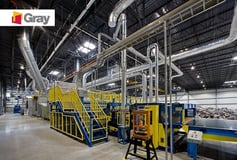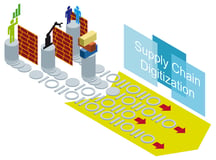Is Your Supply Chain Truly Vertizontal?
Nick Ostdick - February 28, 2017

 Ask any automotive supply chain planner or manager about their top priority in supply chain management and you’ll hear the same thing: The need to cut the complexity of today’s increasingly global, interconnected supply stream and enhance the ability to meet the demands and desires of customers across all corners of the world. While the need to cut complexity is perhaps the most important task for OEMs and suppliers, it can also be extremely difficult given the two most common methods of supply chain integration in today’s landscape: vertical and horizontal.
Ask any automotive supply chain planner or manager about their top priority in supply chain management and you’ll hear the same thing: The need to cut the complexity of today’s increasingly global, interconnected supply stream and enhance the ability to meet the demands and desires of customers across all corners of the world. While the need to cut complexity is perhaps the most important task for OEMs and suppliers, it can also be extremely difficult given the two most common methods of supply chain integration in today’s landscape: vertical and horizontal.
But in the last few years, a new brand of automotive supply chain integration has developed that allows companies to effectively leverage the most effective, integral elements of both vertical and horizontal integration. Vertizontal integration, or the merging of several aspects of vertical and horizontal strategies to foster a lean supply and production strategy, has emerged as a key driver in automotive supply chain management and a critical tool for success in such a variant-rich industry.
By deploying a vertizontal strategy, companies can not only increase efficiency and productivity across each touch point of the value chain, but they can also create greater levels of visibility, transparency, and agility.
Defining vertizontal integration
Before truly understanding the value proposition of vertizontal integration, we must first address and define what vertizontal integration means and what aspects it borrows from its vertical and horizontal linage. Whereas vertical integration relies primarily on combining different stages or producers in the supply chain to enhance production capacity and efficiency, and horizontal integration stems from increasing production capabilities at distinct points in the supply stream to balance areas of deficiency or loss, vertizontal integration combines the collaboration and control associated with vertical and horizontal integration respectively.
To better understand the concept of vertizontal integration, let’s look at the issue of end-to-end (E2E) visibility in the automotive supply chain as an example, which is another great concern for planners and managers. Simply adhering to the principles of vertical integration — greater overall control of the entire value chain with little collaboration between partners and greater risk of disruption because of the dependence on internal production practices, lending to cross-functional silos — would be a giant misstep. However, adopting primarily horizontal integration strategies, which promote less control of the manufacturing and supply chain in favor of third-party vendors or suppliers, would also be a mistake in ensuring the upstream and downstream processes in a planned production facility remain as consistent and timely as possible.
The key, especially given global expansion within the supply stream to include multiple production or warehousing facilities on multiple continents, is to incorporate collaboration with third-party producers, suppliers, and distributors while at the same time optimizing planned production strategies to maintain control in production output. For example, companies would be best advised to implement an optimized BOM solution while then collaborating with a third-party transportation company to ensure the right parts arrive at the right facility at the right time. This hybridization of control and collaboration is key in maintaining planned production schedules and reducing potential bottlenecks or disruptions at the manufacturing and transportation level of the value chain.
Benefits of vertizontal integration
With vertizontal integration clearly defined, let’s look at a few benefits OEMs, manufacturers, and suppliers can experience by leveraging vertizontal integration as part of their supply chain management strategy. Our previous example already highlighted how vertizontal integration can enhance E2E visibility and provides companies with greater insight into their overall supply situation, but vertizontal integration can also enhance an OEM’s:
Transparency. The ability to see beyond what everyone sees. The capacity to drill down into specific aspects of the supply processes in order to unearth areas of waste and potential, and leverage each of these into value propositions for growth. But how does vertizontal integration engender greater transparency in the supply stream? Achieving this may fall more into the horizontal camp, but the ability to reduce risk of disruptions or bottlenecks and increase flexibility over efficiency are core drivers in fostering greater transparency. In order to do this, companies must rely on less centralization of planned production and supply - incorporating multiple facilities, various partners, etc - while at the same time utilizing integrated PFEP (Plan for Every Part) principles to understand with greater insight how each part and part family is to be utilized in planned production - which, more or less, is housed firmly in the vertical integration camp.
Agility. With production and supply hubs located in increasingly disparate parts of the globe, the capacity to adjust, adapt, and rebound to changes and alterations in the production and supply process is a key driver to profitability and productivity. Obtaining this level of agility requires greater communication and collaboration across all touch points of the value chain - a value proposition horizontal integration provides via its reliance on outside vendors in terms of transportation, warehouse and inventory management, and more. Complete supply chain agility is also achieved through walking a fine line between production efficiency and maintaining the necessary maneuverability in production and supply to combat modifications in orders, production schedules, and delivery timetables. A truly agile supply chain looks to merge the control and reduced initial capital of vertical integration with the enhanced collaboration and reduced disruption risk of horizontal integration.
As with so many aspects of today’s global automotive industry, the choice between vertical and horizontal integration in creating a visible, transparent, and agile supply and manufacturing value stream is not an either/or proposition. Companies that can strike a middle ground of vertizontal integration will not only be better equipped to mitigate the nuances of today’s complex production and supply network, but will also be better suited to tackle future challenges as the industry continues to evolve.
LATEST POSTS
- Understand Circular Economy in The Manufacturing Industry
- How Can Industry 4.0 IT Integration Be Achieved Smoothly?
- The Significance of Order Sequencing in Discrete Manufacturing
- How to improve your Supply Chain Management: The Power of Control Towers
- Optimizing Human Resource Scheduling in Manufacturing: A Technological Approach



